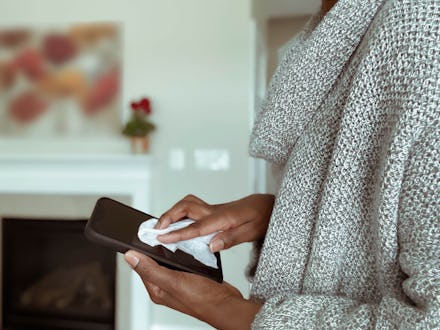Your cell phone is disgusting — but it probably won't give you coronavirus

In the past few days, you might’ve doom scrolled through headlines about a new Australian study that looked at the survival rates of coronavirus on various surfaces in a lab. Much of the media coverage highlighted how the virus could survive on our phone screens for up to 28 days, based on how long the researchers were able to isolate viable virus from a glass surface at room temperature. Given how much time I spend on my phone, the news was a little unsettling. At the same time, my health reporter instincts nudged me to dig past the scary headlines. Do our cell phones really hoard coronavirus germs for that long?
To find out, I spoke with Dean Winslow, an infectious disease doctor and professor of medicine at the Stanford University Medical Center. He thinks the findings should prompt us to be even more careful about not touching our faces immediately after handling oft-touched surfaces — but “people should not be overly concerned.” Although he doesn’t dismiss virus-contaminated objects as an unimportant means of spread, “it should be kept in mind that the highest-risk environment is the indoor environment and the respiratory route.”
Crowded indoor spaces pose a much bigger risk of transmission than our cell phones.
Here’s what Winslow means by that last point: The respiratory droplets that a person infected with the novel coronavirus — a.k.a., SARS-CoV-2, which causes COVID-19 — expels when they sneeze, cough, sing, talk, or breathe, carry the virus, according to the Centers for Disease Control and Prevention. They can spread the virus when these droplets land on others who are within six feet of them. “Under special circumstances,” including enclosed spaces, poor ventilation, and prolonged exposure to respiratory particles (those produced by shouting, for example), SARS-CoV2 can spread through airborne transmission. This refers to when smaller, virus-laden droplets and particles hang in the air for hours, and over distances beyond six feet.
In other words, crowded indoor spaces pose a much bigger risk of transmission than our cell phones. “When you look at the super spreader events, almost all of them have been in crowded indoor environments,” Winslow says. He adds that “it’s really, really important to avoid indoor dining as much as possible.”
The study that spurred the concerning headlines about coronavirus on our cell phones appeared in the journal Virology earlier this month. Researchers from the Commonwealth Scientific and Industrial Research Organisation in Australia measured the survival rates of SARS-CoV-2 on a number of common surfaces, such as glass (like you might find on a cell phone screen or other touchscreen), stainless steel, and paper banknotes, at different temperatures and time points.
They conducted the study in the dark, to limit the effects of UV light on the virus’s survivability. (Indeed, Winslow notes that UV light may help explain why we haven’t really seen huge outbreaks from outdoor events.) SARS-CoV-2 persisted for up to 28 days on these common surfaces at 20 degrees Celsius, or roughly room temperature.
“The science is very solid,” Winslow says of the study, noting that researchers carried it out under reasonable conditions that generally reflect the real world. “I think it’s an important paper.”
That said, “it may be a sort of worst-case scenario that they’re modeling,” he says. Very simply put, the researchers added a high concentration of virus onto each surface — “and it might be kind of artificially high compared to what sorts of virus loads you’d actually find on inanimate objects.”
He explains that they extrapolated the concentration from the amount of virus you’d get if you took a swab directly from an infected person’s nose or throat. They basically modeled what we might expect if we were to take that swab and smear it on a surface, or a comparable situation.
A more common real-world scenario would involve, say, a pre-symptomatic or asymptomatic person at the grocery store not wearing a properly fitted mask, and a couple of respiratory droplets escaping and falling onto the touchscreen at checkout. “That, again, is a much lower inoculum than what the scientists tested,” Winslow explains.
The absence of UV light in the study also mirrors the worst-case scenario, or in other words, indoor environments. “There’s not much UV light indoors,” Winslow says.
Overall, the findings emphasize the importance of frequent hand-washing, particularly after contact with high-touch surfaces like touch screens, doorknobs, and banisters — not so much your personal cell phone, because by and large, it carries only your own germs, Winslow explains. “I think people shouldn’t worry too much about this,” he says when I ask him how much we need to worry about contracting SARS-CoV-2 from our cell phones. “I don’t think they need to worry about decontaminating their own personal cell phone.” Stay vigilant, but don’t panic, and worry more about crowded indoor spaces, especially as it gets colder.